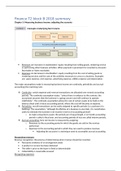College aantekeningen
Statistics II: Applied Quantitative Analysis SPSS Exam Cheat Sheet - GRADE 8,7
Summary of the material for the final SPSS exam (2022) for Statistics II: Applied Quantitative Analysis. INCLUDES a cheat sheet of the course’s general information, SPSS commands and functions (Total: 35 pages).
[Meer zien]





